I am glad you give a detailed account of your journey with interesting pictures. This kind of adventure could only exist in my dreams as leaving one's home, job and family for an extended period of time is such an important decision in life that could change everything. I have shared your stories and those of others with my offroading buddies and they could not believe that such adventure like yours could be done. Well, we are just weekend adventurers!
You are using an out of date browser. It may not display this or other websites correctly.
You should upgrade or use an alternative browser.
You should upgrade or use an alternative browser.
unURBAN Adventures - Alaska to Argentina to AFRICA!
- Thread starter unURBAN
- Start date
HumphreyBear
Adventurer
Hey E&M,
I've just read your whole trip in a couple of days and want to thank you for the wonderful trip reports and (muy muy) beautiful photos, and also your sense of adventure which is engrossing. Evidently has already engrossed many many more.
I spent a few months in Bolivia in 2006 and we called it the Land of the Blind Shop Keepers because everytime we asked for something they would respond with "No hay, no hay". With your hunt for diesel it looks like things haven't changed...
Kind Regards,
Humphrey
I've just read your whole trip in a couple of days and want to thank you for the wonderful trip reports and (muy muy) beautiful photos, and also your sense of adventure which is engrossing. Evidently has already engrossed many many more.
I spent a few months in Bolivia in 2006 and we called it the Land of the Blind Shop Keepers because everytime we asked for something they would respond with "No hay, no hay". With your hunt for diesel it looks like things haven't changed...
Kind Regards,
Humphrey
Dgurley2000
Adventurer
Well, that was anti-climatic - especially after I read the blog post on ExPo about 200-300 people dying a year on the road
Are you planning on posting GPS information for routes that you didn't find on the "best" maps?
Your photos of the Andes are stunning!
DiploStrat
Expedition Leader
Lived in Bolivia for three years so it was great to see your pictures. Enjoy Sucre and look forward to your mine tour in Potosi! :Wow1:
Salar de Uyuni
Since we started planning this trip Espen has looked forward to Salar de Uyuni. Even more so after reading and seeing the amazing photos from the Salar in the summer edition of Overland Journal 2010.
.
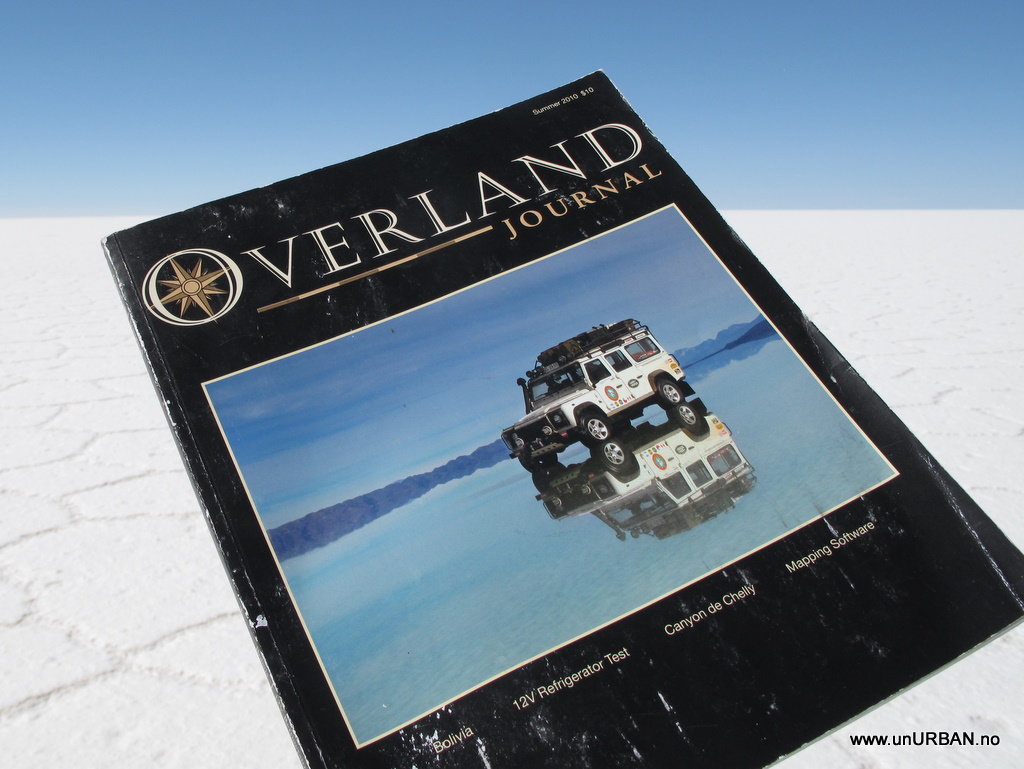
.
And now we were in Bolivia and getting really close to one of the highlights of this trip.
.
In Sucre we meet up Andrea and Georg (www.toyotours.com) again. We both though it would be good to drive two cars together to Salar de Uyuni and Routa de Lagunas, for safety, and of course it is nice with some travel companions. Sucre was also where we stocked up with food, water and drinks that would last us for more than a week. Espen and I bought 1 kg of minced meat and 1 kg of chicken filets in the marked. I cooked it all (so it would last longer) and stored it in zip-lock bags in the fridge for the week to come. After one final Italian (Sucrean) pizza we were ready for the wilderness.
.
Bolivia have subsidized fuel for it citizens, 3, 70 bolivianos per liter of diesel (0, 53 usd). Recently the government made some regulations so that international customers had to pay the international price, 8, 60 bolivianos per liter (1, 24 usd). This is to prevent people from neighboring countries filling up with cheap fuel and take it across the border. So far we have had no problems filling up with fuel for local price, but between Sucre and Potosi we stopped at three gas stations before we could fill up with diesel. But we were not allowed to fill our 20 liter jerry can.
.
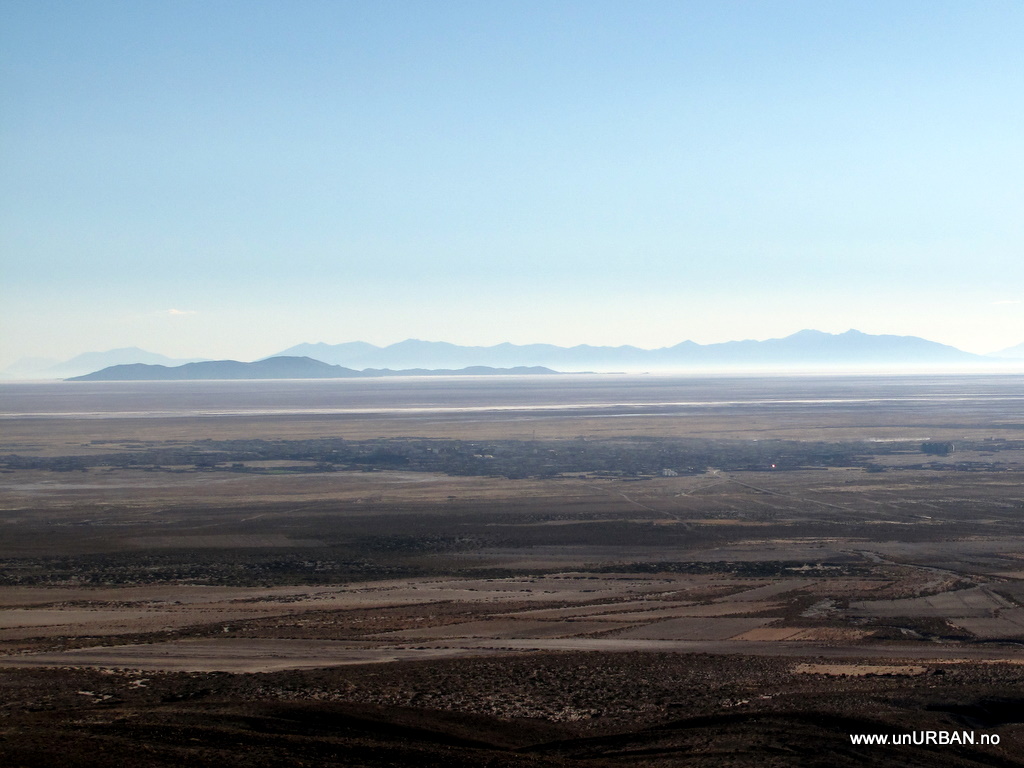
.
After a long day on the road we finally approached the city of Uyuni. It is this strange “last city” outpost in the middle of nowhere. Getting closer to the city we could see how plastic is produced, it grows on small bushes out in the desert…..
.
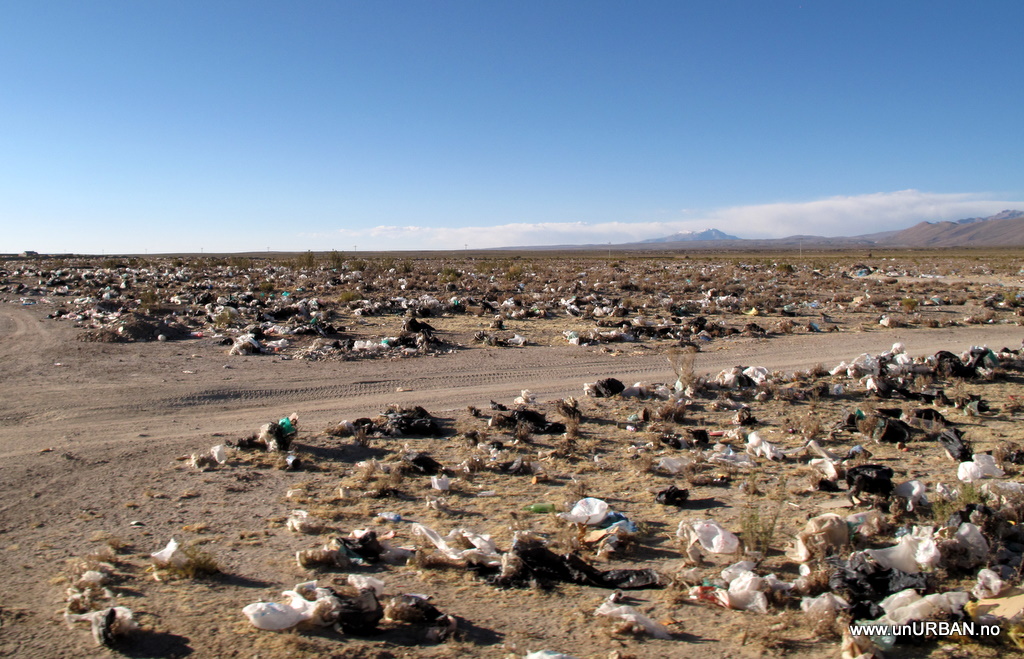
.
It is sad to see nature so full of plastic garbage. This is what happens in windy places when the garbage is just dumped at the side of the road, the wind picks it up and distributes it all over the place where it can tangle up.
.
There were three things we wanted in Uyuni and the first and most important was to fill up with more fuel. Here we were prepared to pay the international price, but as long as we did not want any receipt we could pay the local price. Even the jerry can got filled up. Second we bought bread, lots of bread. And the third stop in Uyuni was the train cemetery a couple of kilometers outside town. It was strange to see all these old trains parked out in the middle of nowhere next to the train tracks which they would never get back on.
.
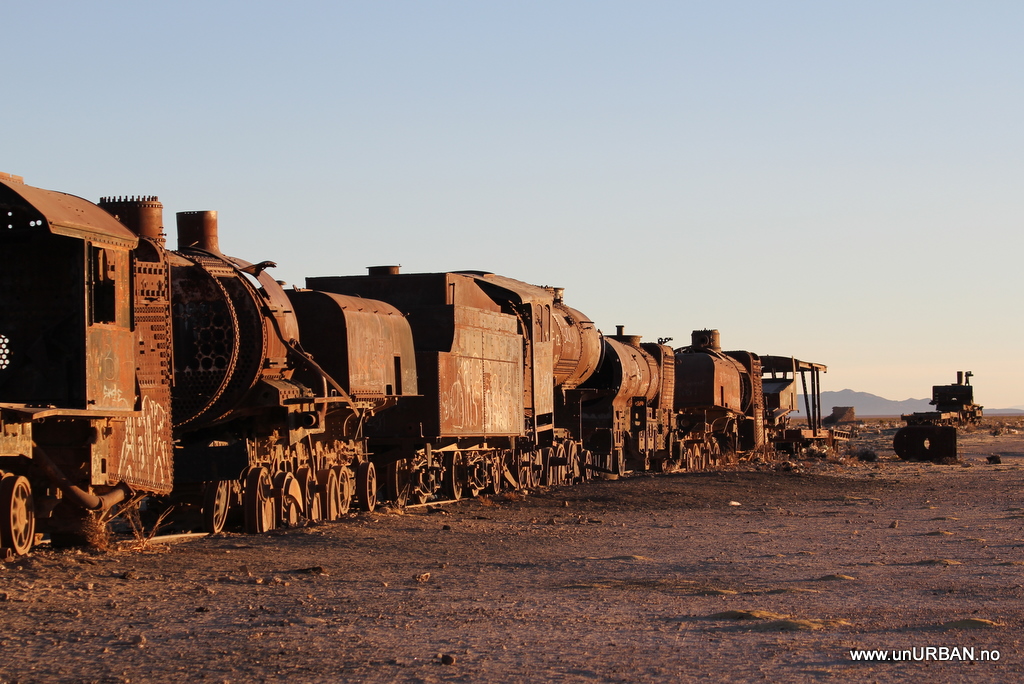
.
By now the sun was setting so we had to get moving to get a glimpse of Salar de Uyuni before it got totally dark. We just made it as the last vehicles were leaving the salt flats for the evening.
.
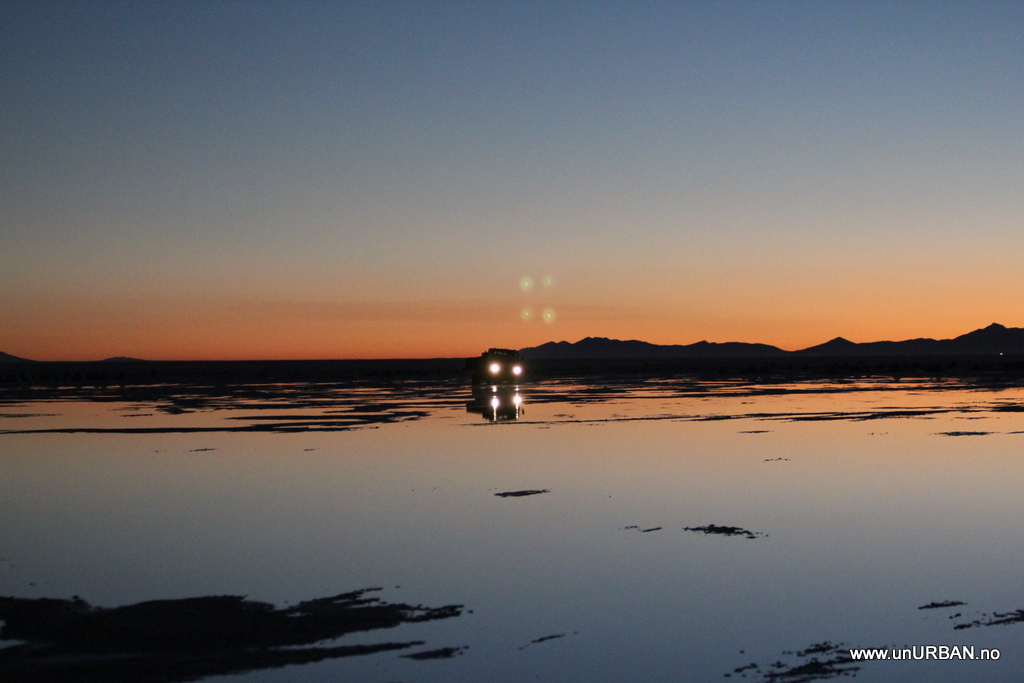
.
Where you can enter the Salar de Uyuni at Colchani there is quite a bit of water, and since this really salty water is not good for the car we wanted to avoid it. We had been told that it was just to drive 300 meters more to the right to avoid the water, and this turned out to be right. The Patrol got onto the Salar with almost dry tires. After driving a few kilometers out in the dark we found a nice flat spot, which is not really very difficult on the world’s largest salt flat… And set up camp.
.
When arriving in a new place in the dark it is always exciting to wake up in the morning and see your surroundings for the first time.
.
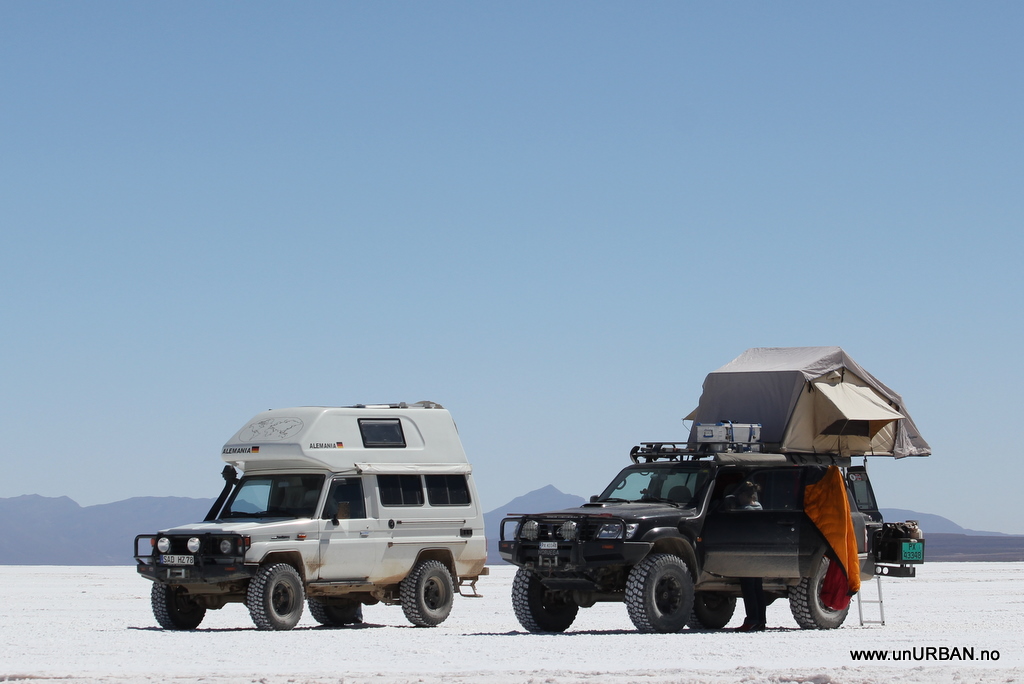
.
Climbing down the stairs from the roof top tent in the morning I felt like being in Antarctica. As far as I could see it was white, white, white, and flat, with just a few hills in the distance. What made me realize that it was not Antarctica was that the mountains had no snow on them and when you walked around on the “snow” you did not break through the hard surface. Since the Salar de Uyuni is up at 3650 meters is was cold in the morning so breakfast was enjoyed with the down jacket on (best piece of clothing in the world!).
.
From the “entrance” of the Salar we headed to Isla Incahuasi which was 80 km away driving over the salt. On the way to the Island we stopped and played around taking some photos.
.
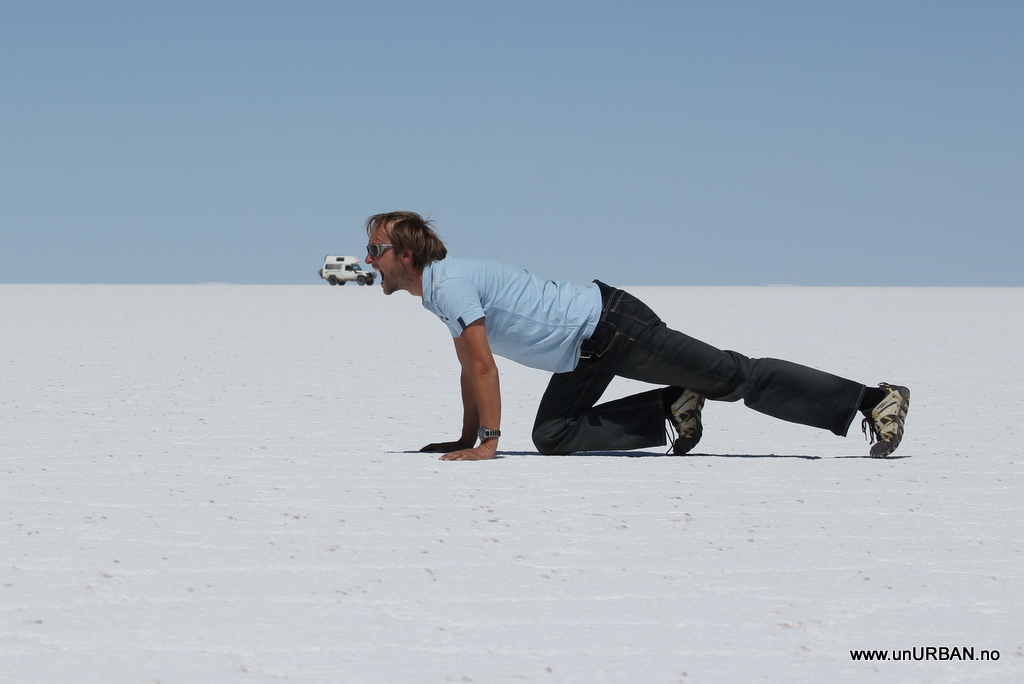
.
Espen felt tempted to have a taste of a Toyota (still prefer Patrol….).
.
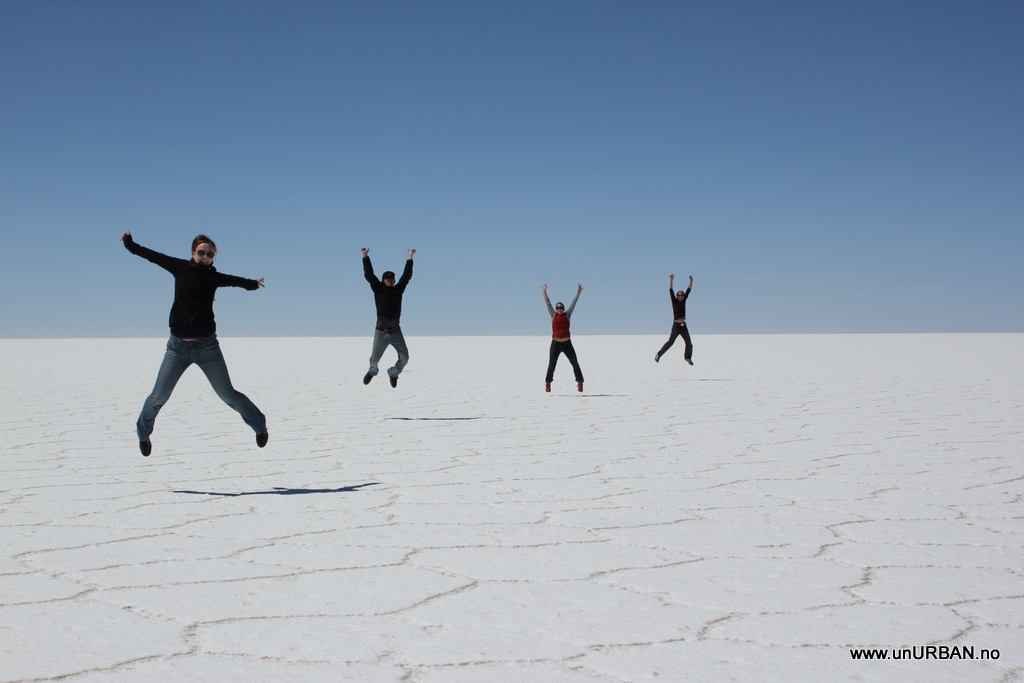
.
Happy travelers that actually managed get synchronized and jump at the same time on try 16, or was it 36?
.
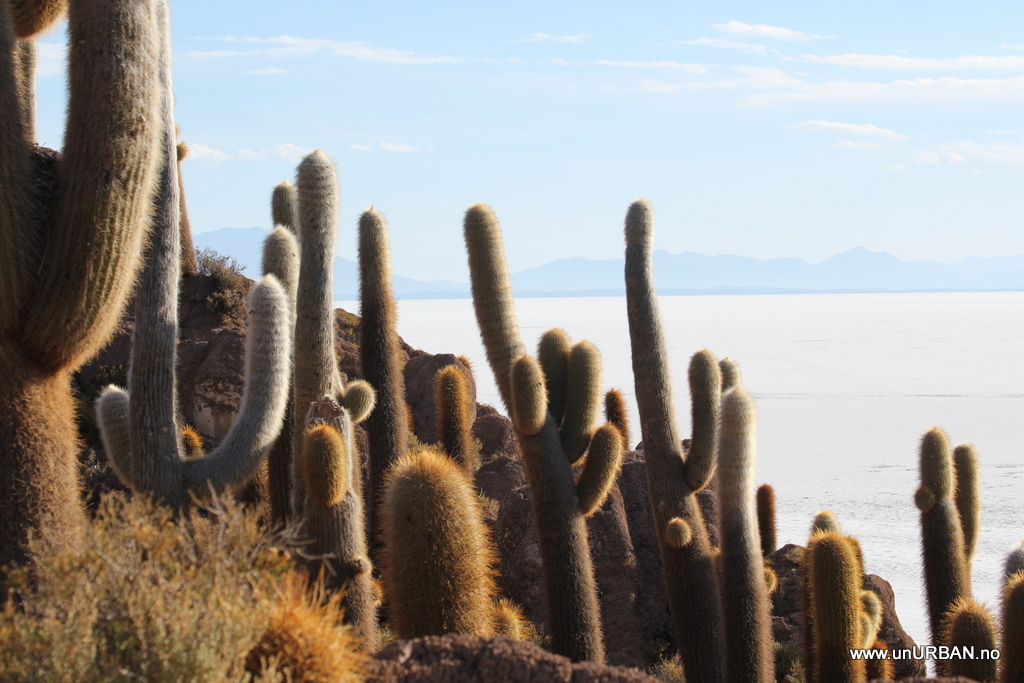
.
Isla Incahuasi is an island in the middle of the Salar where hundreds of Cactus grows. An information sign told us that some cacti are 900 years old… Talking about age, I got one year older the day before, but we had no time to celebrate then because of the long driving day.
.
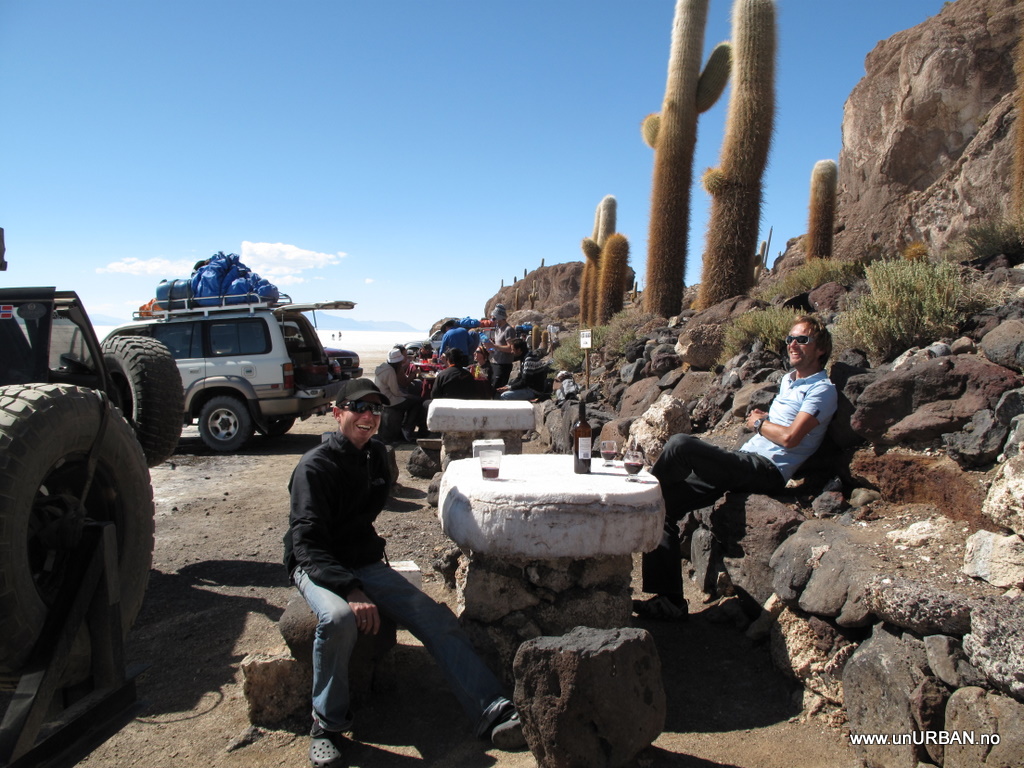
.
So among the cactus, that is way older than me, and at a salt table, it was time for some red wine!! After wine it was time for dinner, and it was cooked on salt… If you notice the small white and blue container, it is salt.
.
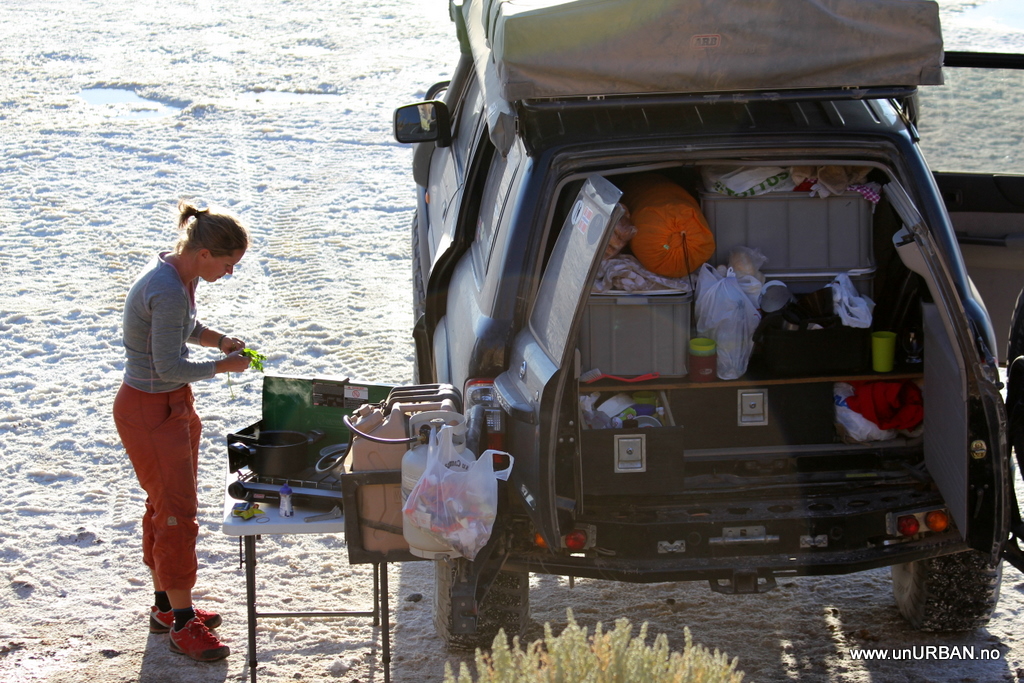
.
We managed to bring salt to the world’s largest salt flat where the Bolivians produce 18.000 ton of salt a year for human consumption.
.
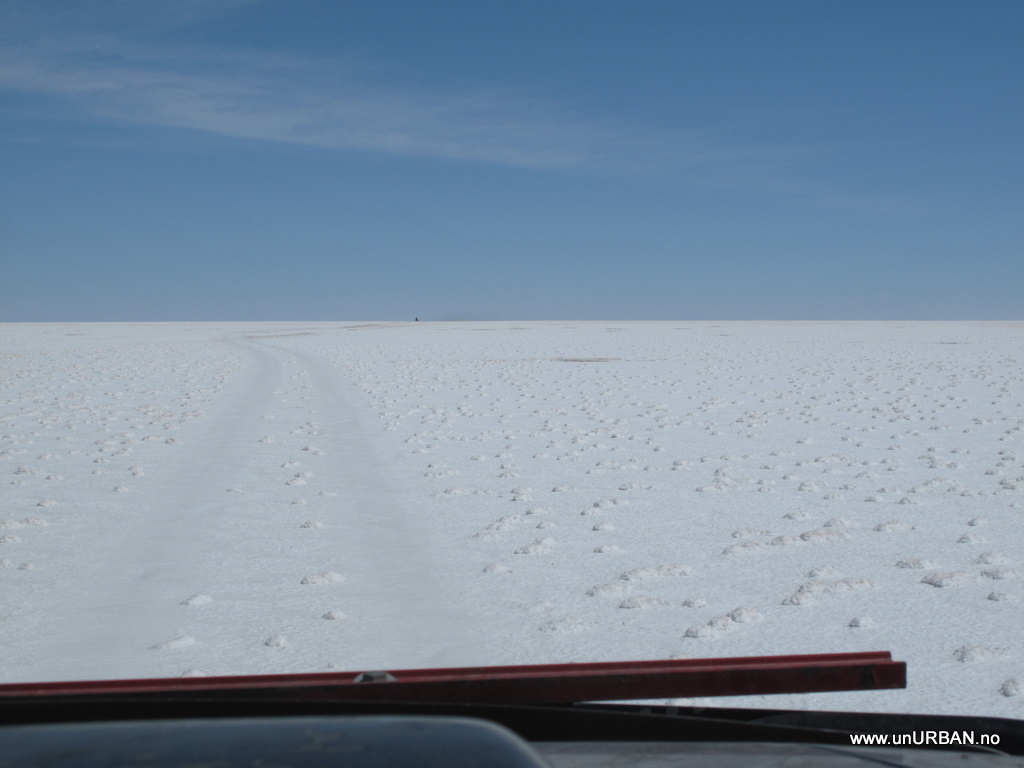
.
Salar de Uyuni is an incredible and amazing place to travel and to be for a few days. It feels surreal driving on this surface with a vehicle, but of course even the largest salt flat in the world had to come to an end as we travelled south towards Ruta de Lagunas. More about that soon!
.
M&E
Since we started planning this trip Espen has looked forward to Salar de Uyuni. Even more so after reading and seeing the amazing photos from the Salar in the summer edition of Overland Journal 2010.
.

.
And now we were in Bolivia and getting really close to one of the highlights of this trip.
.
In Sucre we meet up Andrea and Georg (www.toyotours.com) again. We both though it would be good to drive two cars together to Salar de Uyuni and Routa de Lagunas, for safety, and of course it is nice with some travel companions. Sucre was also where we stocked up with food, water and drinks that would last us for more than a week. Espen and I bought 1 kg of minced meat and 1 kg of chicken filets in the marked. I cooked it all (so it would last longer) and stored it in zip-lock bags in the fridge for the week to come. After one final Italian (Sucrean) pizza we were ready for the wilderness.
.
Bolivia have subsidized fuel for it citizens, 3, 70 bolivianos per liter of diesel (0, 53 usd). Recently the government made some regulations so that international customers had to pay the international price, 8, 60 bolivianos per liter (1, 24 usd). This is to prevent people from neighboring countries filling up with cheap fuel and take it across the border. So far we have had no problems filling up with fuel for local price, but between Sucre and Potosi we stopped at three gas stations before we could fill up with diesel. But we were not allowed to fill our 20 liter jerry can.
.

.
After a long day on the road we finally approached the city of Uyuni. It is this strange “last city” outpost in the middle of nowhere. Getting closer to the city we could see how plastic is produced, it grows on small bushes out in the desert…..
.

.
It is sad to see nature so full of plastic garbage. This is what happens in windy places when the garbage is just dumped at the side of the road, the wind picks it up and distributes it all over the place where it can tangle up.
.
There were three things we wanted in Uyuni and the first and most important was to fill up with more fuel. Here we were prepared to pay the international price, but as long as we did not want any receipt we could pay the local price. Even the jerry can got filled up. Second we bought bread, lots of bread. And the third stop in Uyuni was the train cemetery a couple of kilometers outside town. It was strange to see all these old trains parked out in the middle of nowhere next to the train tracks which they would never get back on.
.

.
By now the sun was setting so we had to get moving to get a glimpse of Salar de Uyuni before it got totally dark. We just made it as the last vehicles were leaving the salt flats for the evening.
.

.
Where you can enter the Salar de Uyuni at Colchani there is quite a bit of water, and since this really salty water is not good for the car we wanted to avoid it. We had been told that it was just to drive 300 meters more to the right to avoid the water, and this turned out to be right. The Patrol got onto the Salar with almost dry tires. After driving a few kilometers out in the dark we found a nice flat spot, which is not really very difficult on the world’s largest salt flat… And set up camp.
.
When arriving in a new place in the dark it is always exciting to wake up in the morning and see your surroundings for the first time.
.

.
Climbing down the stairs from the roof top tent in the morning I felt like being in Antarctica. As far as I could see it was white, white, white, and flat, with just a few hills in the distance. What made me realize that it was not Antarctica was that the mountains had no snow on them and when you walked around on the “snow” you did not break through the hard surface. Since the Salar de Uyuni is up at 3650 meters is was cold in the morning so breakfast was enjoyed with the down jacket on (best piece of clothing in the world!).
.
From the “entrance” of the Salar we headed to Isla Incahuasi which was 80 km away driving over the salt. On the way to the Island we stopped and played around taking some photos.
.

.
Espen felt tempted to have a taste of a Toyota (still prefer Patrol….).
.

.
Happy travelers that actually managed get synchronized and jump at the same time on try 16, or was it 36?
.

.
Isla Incahuasi is an island in the middle of the Salar where hundreds of Cactus grows. An information sign told us that some cacti are 900 years old… Talking about age, I got one year older the day before, but we had no time to celebrate then because of the long driving day.
.

.
So among the cactus, that is way older than me, and at a salt table, it was time for some red wine!! After wine it was time for dinner, and it was cooked on salt… If you notice the small white and blue container, it is salt.
.

.
We managed to bring salt to the world’s largest salt flat where the Bolivians produce 18.000 ton of salt a year for human consumption.
.

.
Salar de Uyuni is an incredible and amazing place to travel and to be for a few days. It feels surreal driving on this surface with a vehicle, but of course even the largest salt flat in the world had to come to an end as we travelled south towards Ruta de Lagunas. More about that soon!
.
M&E
Bergum
Adventurer
.
I got one year older the day before, but we had no time to celebrate then because of the long driving day.
Happy birthday! Gratulerer med dagen..
If you notice the small white and blue container, it is salt.
We managed to bring salt to the world’s largest salt flat where the Bolivians produce 18.000 ton of salt a year for human consumption.
Så, jeg må jo bare spørre.
Fikk dere fylt opp saltbøssa? :chef:
(Did you stock up on salt?)
rockandroll
Adventurer
Nostalgia
Loved the Salar update. Cannot wait to get out there.
It's raining here in La Paz, so I'm browsing your USA posts via the blog over coffee. Leading me to be nostalgic for the states. You chose a great route! I'd like to do the exact same when we get back.
Loved the Salar update. Cannot wait to get out there.
It's raining here in La Paz, so I'm browsing your USA posts via the blog over coffee. Leading me to be nostalgic for the states. You chose a great route! I'd like to do the exact same when we get back.
....as leaving one's home, job and family for an extended period of time is such an important decision in life that could change everything.
It does, it does... And the whole thing starts with weekend adventuring - be carefull!
E&M
I've just read your whole trip in a couple of days and want to thank you for the wonderful trip reports and (muy muy) beautiful photos, and also your sense of adventure which is engrossing. Evidently has already engrossed many many more.
I spent a few months in Bolivia in 2006 and we called it the Land of the Blind Shop Keepers because everytime we asked for something they would respond with "No hay, no hay". With your hunt for diesel it looks like things haven't changed...
Hi Humphrey!
Thanks for commenting! I would guess that Bolivia is still the same. You can find pretty much what you need, but might have to look around a bit, and also be prepared to accept substitutes...
E&M
Well, that was anti-climatic - especially after I read the blog post on ExPo about 200-300 people dying a year on the road
Are you planning on posting GPS information for routes that you didn't find on the "best" maps?
Your photos of the Andes are stunning!
Dgurley2000,
It IS a spectacular road, but there are just so many... And now as the road doesn't see much traffic, I don't think there are many deaths per year. We heard about a downhill biker or two. However, back in the days of heavy, two way truck traffic, I would probably think twice about driving down...
.
We don't really have many saved tracks/routes. This has kind of become one of the projects or plans that never quite made it. Our Garmin Nuvi 255w can only save a limited number of points on a track, and we have to connect it to the laptop every second day tyo make sure we save our tracks. This has been neglected. Still, we have kept some routes, and when we find a little bit more time to work on our pages, we'll try to update some maps with approximate route info. As soon as you get away from the main roads down here, we find that even "the best" maps are not even close to the actual roads and villages.
E&M
Sooo, what about Chile ??? .... :sombrero::wings: , is it nice ? :ylsmoke:
YES! It is really nice! Loved Atacama! On the coast we found cold fog, and only stayed for a couple of nights.
We're now in Mendoza in Argentina, but we'll be crossing the border to Chile and Santiago area in about 8-10 days (we think...). Up for a coffee???? Would be nice with some pics of the two nicest trucks on the continent.... :-D
E&M
Similar threads
- Replies
- 8
- Views
- 1K
- Replies
- 14
- Views
- 3K
- Replies
- 376
- Views
- 95K
- Replies
- 27
- Views
- 10K
